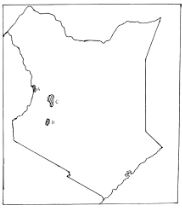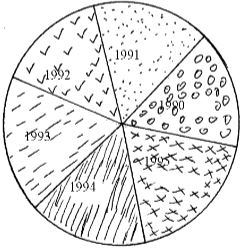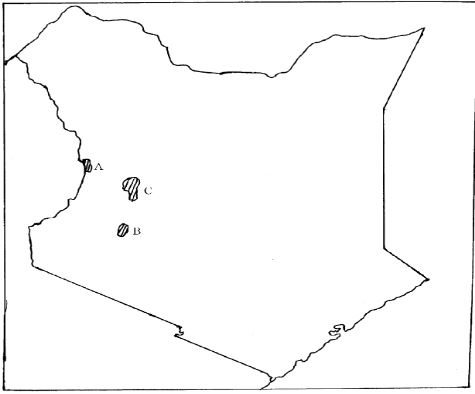- Name three patterns of human settlements. (3mks)
-
- List any two products from Jua kali industry in Kenya exported to other countries. (2mks)
- Name two renewable sources of energy used in Kenyan industries. (2mks
-
- Name three surfaces that are reclaimed in Kenya. (3mks)
- Identify the method of reclamation used in each surface mentioned in 3(a) (3mks)
- Explain how the following practices help in soil conservation
- Mulching (2mks)
- Terracing (2mks)
-
- Describe how deep-shaft mining takes place. (5mks)
- Name three products from an oil refinery other than petrol. (3mks)
SECTION B
Answer question 6 and any other two questions in this section.
- The table below shows milk yield in kilograms per dialy cow in Denmark between 1990 and 1995.
Year 1990 1991 1992 1993 1994 1995 Yields in Kg 5243 6693 7398 7610 7792 7946 -
- Draw a divided circle of radius 3-5cm to represent the milk yield in Denmark
Show all your calculations (2mks) - State two advantages of using the divided circle to represent data (2mks)
- Name two other methods, apart from the divided circle, that could be used to represent the above data. (2mks)
- Draw a divided circle of radius 3-5cm to represent the milk yield in Denmark
- Explain three physical factors that have favoured farming in Denmark (6mks)
- State three problems facing dairyFarmers in Kenya (3mks)
- Explain two reasons why beef farming is more developed in Argentina than in Kenya. (4mks)
-
-
-
- State any two forms in which minerals occur (2mks)
- Name any three places where limestone is mined in Kenya (3mks)
- Explain how the following factors influence the exploitation of a mineral
- Market (2mks)
- The quality of ore (2mks)
- Technology (2mks)
-
- Name two provinces in south Africa where gold is mined (2mks)
- Explain three problems facing gold mining in south Africa (6mks)
- Describe the processing of diamond in south Africa.
-
-
-
- Apart from oil, name two sources of non-renewable energy. (2 mks)
- List three advantages of solar energy. (3 mks)
- Explain four problems encountered in mineral exploitation in Kenya. (8 mks)
- Explain the effects of over-relience on oil as a source of energy. (8 mks)
- State four methods the Government of Kenya uses to manage and conserve her energy resources. (4 mks)
-
-
-
- define the term forestry. (1 mark)
- Give three differences between natural forest and planted forests.(3 marks)
- Explain FOUR causes of forest depletion in Kenya today. (8 marks)
-
- From the map below, give the names of the forests marked A, B ad C
- State FOUR measures that are being undertaken by the Kenya Government to conserve forests. (4 marks)
- From the map below, give the names of the forests marked A, B ad C
- Explain THREE factors favouring the exploitation of softwoods in Canada (6mks)
-
MARKING SCHEME
- Name three patterns of human settlements
- Dispersed
- Nucleared
- Linear
-
- List any two products from Jua kali industry in Kenya exported to other countries. (2mks)
- Jikos
- Ciondos
- Wheel barrows
- Basket / mats
- Name two renewable sources of energy used in Kenyan industries .
- Wind
- Wood
- Solar
- Geothermal / underground steam
- List any two products from Jua kali industry in Kenya exported to other countries. (2mks)
-
- Name three surfaces that are reclaimed in Kenya
- Deserts
- Swamps
- Tsetse infested valleys
- Flood prone plains
- Identify the method of reclamation used in each surface mentioned in 3.(a) (3mks)
- Deserts irrigation
- Swamps – Draining
- Tsetse – Chemical / Biological
- Floods – Earth dams
- Drainage ditch
- Dykes
- Name three surfaces that are reclaimed in Kenya
- Explain how the following practices help in soil conservation
- Mulching
- Protects the soil from erosion
- Reduces evaporation
- Adds humus
- Increases micro organism
- Terracing
- Reduces erosion (2mks)
- Allows water rentention and inflitration ( more moisture)
- Mulching
-
- Describe how deep shaft mining takes place.
- Shaft dug / hole dug to reach the ore
- Horizontal tunnels penetrate the ore areas
- Props support the tunnels roof
- Laying the light railway for transportation of ore
- Explosives blast / digging out of the ore
- Ore is brought to the base of the shaft and loaded into cages
- The lift system left the ore to the surface for processing.
- Name three products from an oil refinery other than petrol.
- Asphalt/ Tar
- Grease
- Gas
- Kerosene
- Describe how deep shaft mining takes place.
SECTION B
-
-
- A divided circle showing milk yield in Denmark per cow in kg (1mk)
= Total yield(kg) = 5243 +6693 +7398 +7610 +7792 +7946 = 42,682 = 360°
1990 = 5243 x 360° = 44.22°
42682
1991 = 6693 x 360° = 56.45°
42682
1992 = 7398 x 360° = 62.40°
42682
1993 = 7610 x 360° = 64.19°
42682
1994 = 7792 x 360° = 65.72°
42682
1995 = 7946 x 360° = 67.02°
42682
(Each calculate ½ mk)
Each segment well done ½ mk
Title 1mk
Key (or impleed) 1mk - Two advantages of using a divided circle
- Attractive / good visual impression
- Good for comparison
- Easy to read / Interprete
- Easy to draw / construct
- Two other methods other than a divided circle
- Simple bar graph
- Divided rectangle
- A divided circle showing milk yield in Denmark per cow in kg (1mk)
-
- Factors favouring dairy farming in Denmark
- The low lying and relatively flat landscape makes it ideal for dairy farming
- The average height of the land is about 30M above sea level.
- The average monthly temperature in Denmark is about 7-9oc.The warm sunny summers are suitable for out door grazing.
- The soil, derived from boulder clay are fertile for growth of pasture.
- High rainfall of 500 -1500 MM p.a suitable for livestock and pasture
- Provides also water for livestock. (Any 3x2=6mks)
- Problems facing dairy farmers in Kenya
- Insufficient feeds
- Poor management of dairy co-operative societies
- High cost of production. Especially cattle feeds, drugs and veterinary services.
- Poor infrastructure
- Shortage of proper milk storage facilities
- Attack by pests and diseases eg ECF. Ticks.
- Inadequate / veterinary services
- Inadequate veterinary training to fairly farmers
- Collapse of the diseases control system ie cattle dips in most parts of Kenya. (Any 3x1=3mks)
- Factors favouring dairy farming in Denmark
- Why beef farming is more developed in Argentina than in Kenya.
- Enough pasture and adequate water for livestock in Argentina due to moderate rainfall of 1000MM than in Kenya.
- Moderate temperature of 240C during summers and above 100C in winter ensures continuous growth of pasture Argentina than in Kenya.
- Fertile soils give rise to healthy natural pastures for livestock in Agentina than in Kenya.
- High quality exotic cattle breeds from Europe.
- Well developed infrastructures eg railway network for beef transportation.
- Large scale ranches which are well managed and mechanized.
- Availability of adequate capital
- Availability of both local and foreign markets. (Any 2x2=4mks)
-
-
-
- Forms of which minerals occurs
- Veins and lodes
- Beds and seams
- Weathering products
- Alluvial / placer deposits
- Three places where limestone is mined in Kenya
- Bamburi
- Athi River
- Sultan Hamud
- Homa bay
- Koru
- Kerio –valley
- Kariandusi
- Forms of which minerals occurs
- Factors explained
- Market
- Ready market will lead to mining of a mineral
- Uncertain market reduces / minimizes mining
- The quality of ore
- Higher the grade / ores are economical to extract as they yield a large amount income.
- Low quality ores are rarely extracted as their metal content is very low.
- Important minerals eg uranium are mined despite their low quality.
- Technology
- Exploitation of any mineral depends on the level of development of a country since it requires advanced technology.
- Market
-
- Two provinces in south Africa where gold is mined.
- Orange Free State
- Lyden bury
- Witwatersland
- Ogendaolvos
- Three problems facing gold mining in south Africa (explaining)
- Deepening of mines of gold bearing rocks which lie deeply underground hence experiencing to mine
- Low Gold content in the ore because of exhaustion
- Poor quality of the ore as the mines get deeper
- Labour shortage is due to competition of labour from other sectors and the increasing demands by laborers like wages married staff quarters.
- Inadequate water supply on the surface areas as gold requires large amounts of water for purification.
- Exhaustion of mines eg the old rand mines. (3x2=6mks)
- Two provinces in south Africa where gold is mined.
- Description of diamond processing in S.Africa
- There is blasting o frocks ore from the underground
- The rock is then crushed into small pieces
- It is then washed using water to remove dirt
- The remaining rock pieces that contain diamonds is passed over a rotating table that is covered with grease.
- Water is then passed over the rotating table to remove the dirt and unwanted rock material.
- Diamond is then removed
- The process is replaced several times (6mks)
Sequence must be followed
-
-
-
- Two sources of non-renewable sources of energy.
- Coal
- Nuclear energy
- Natural gas (1×2 = 2mks)
- Advantages of solar Energy.
- It’s free
- Found anywhere
- Its renewable
- It’s clean (1×3=3 mks)
- Two sources of non-renewable sources of energy.
- Four problems involved in mineral exploitation in kenya.
- Local communities are rarely involved hence tend to oppose mining.
- Compensation of the displaced is very expensive and not transparent.
- The local community hardly want to move from their ancestral lands.
- Some areas of mineral potential are unlinked – roads, rail to other parts of the country / poor transport / roads.
- Scarcity of capital for Government to invest in mineral prospecting.
- Minerals are of relatively small quantities to qualify mining hence fetch little capital
- Most minerals are of low value hence fetch low prices (2 ×4 = 8 mks)
- Effects of over-reliance on oil as a source of energy.
- A lot of foreign exchange reserve is used in oil importation. This affects other sectors of the economy.
- When prices of oil increase, non-oil producing states, economy is affected.
- May lead to increase of prices of goods resulting from inflation.
- May affect agricultural production resulting to scarcity of food / raw materials.
- May result to increase of fares that is passed on to passengers.
(2×4=8 mks)
- Four methods Government uses to conserve her energy resources.
- Power rationing / water rationing
- Afforestation / Reforestation programmes
- Encouraging passengers to use public transport as much as possible.
- Encouraging people to use renewable forms of energy e.g. biogas, HEP, wind other than oil.
- Use of more efficient energy saving devices to reduce the amount of oil/energy used.
- By smoothening road surfaces to avoid delays that may lead to more use of fuel.
-
-
-
- Define the term forestry. (1 mark)
- It is the science of developing and managing forest or
- It is the practice of managing and using trees, forests and their associated resources for human benefits or
- It is the art of planting, tending, managing and extracting forest products.
(2 marks)
- Give three differences between natural forest and planted forests. (3marks)
- Natural forests comprise of indigenious trees while planted forests are mainly composed of exotic trees
- Trees in natural forests are of mixed species while in planted forests trees are of one species
- Trees in natural forests grow haphazardly while in man-made forest trees are planted in rows
- Forests of the natural type spread from lowland to highland while planted forests are found in the highlands
- Thick undergrowth in natural forests but less undergrowth in planted forests
- Natural forest have canopy while man-made has none
- Natural forests have trees that yield hardwood while in planted forests trees yield softwoods
Any 3 x 1 mark=3 marks
- Define the term forestry. (1 mark)
- Explain FOUR causes of forest depletion in Kenya today.(8 marks)
- Fire outbreaks like the one that happened on Mount Kenya recently destroy large tracts of forests
- Pests and diseases also kill trees leading to forest depletion
- Population explosion has raised demand for wood which has resulted into overexploitation of the forests
- Forest encroachment by man has reduced area under forests
- Industrialization –setting up of industries that use timber as their raw materials has led to deforestation
- Adverse climatic conditions e.g prolonged drought make trees to die
- Illegal felling of trees hence their depletion
-
- From the map below, give the names of the forests marked A, B ad C
- Mt. Elgon forest
- Kakamega forest
- Cherangani hills forests
Any 3 x 1 mark=3 marks
- State FOUR measures that are being undertaken by the Kenya Government to conserve forests. (4 marks)
- Enforcing afforestation and re-aforestation programs
- Involving the local communities in forest conservation
- Scientific management of trees e.g spraying against diseases and pests, pruning, thinning, carrying out research
- Creating awareness through education about the need to conserve forests
- Creation of buffer zones to eradicate forest encroachment
- Increasing forest guards to reduce illegal felling of trees
- Imposing stiff penalties through legislation on illegal loggers
- Use of alternative sources of energy particularly the renewable like solar, electricity to reduce reliance on forest for energy.
- Perimeter fencing of National parks to stop wild animals invading forests
- Reduction of wastage e.g use of economic jikos
Any 4 x 1 mark=4 marks
- From the map below, give the names of the forests marked A, B ad C
- Explain THREE factors favouring the exploitation of softwoods in Canada. (6marks)
- The many rivers in Canada provide adequate hydro-electric power for the pulp and prayer as well as other related industries
- The mild winters with ice-free waters in British Columbia make it possible to transport logs all year round using rivers
- The many rivers provide plenty of water needed in pulp and paper industries
- Excellent transport system ensures fast ferrying of logs to the factories and the finished products to the market
- High domestic as well as international market enhances continuous exploitation
- Proximity of adequate capital necessary in forest management as well as establishment of related industries.
-
Download Geography Paper 2 Questions and Answers - Form 3 End Term 2 Exams 2023.
Tap Here to Download for 50/-
Get on WhatsApp for 50/-
Why download?
- ✔ To read offline at any time.
- ✔ To Print at your convenience
- ✔ Share Easily with Friends / Students




